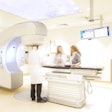Healthcare will shift in the next 25 years to a personalized and pre-emptive model, and imaging innovation will drive that change, according to speakers at a briefing this week on the future of medical imaging.
"Medicine in the future has to be predictive, personalized, and very precise to the individual, and it has to be pre-emptive," said Dr. Elias Zerhouni, director of the National Institutes of Health (NIH). He spoke along with several other speakers Tuesday at a briefing in Washington, DC, sponsored by the National Electrical Manufacturers Association (NEMA).
Imaging will play a key role in meeting a number of core scientific challenges in the future, the most important of which is understanding complex biological systems, Zerhouni said.
"When you look at the ability to study the system dynamically in its complexity, and the ability to find ways of understanding the information transfer that occurs between molecules, you realize that imaging becomes central to progress in the future," he said.
In its most profound sense, imaging is the science of extracting spatially and temporally resolved information at all physical scales, he said. Innovation in imaging is heavily dependent on interdisciplinary interactions, requiring great mastery of physics, computer sciences, image formation, and biology, according to Zerhouni.
"This cycle of innovation is truly what I think we're talking about in the next 25 years," he said. "How these interdisciplinary fields interact in a positive way to extract that information out of complex systems is, in my view, the core challenge for NIH's scientific support of this area of research."
Research trends include detection of subclinical disease, image "understanding" and quantitation (such as CAD and neuroscience), in vivo cellular and molecular imaging, and image-guided interventions, Zerhouni said.
"Twenty-five years from now, I hope that we won't perform any more open surgery," he said. "There would be no need to essentially take the risk of full exposure of the human body to go to a targeted region that needs to be affected."
Imaging is relevant at all scales, including molecular (enzyme function), macromolecular assemblies, cellular (in-cell trafficking), and tissue (tracking changes in organs over time), Zerhouni said.
"To identify the patient at risk, we will need the ability to explore the human body noninvasively. The only science that can do this really is medical imaging at all scales, to understand from one scale to the next to the next how the pathobiology of the disease evolves" in order to facilitate intervention, he said.
As a result, imaging will help spur the transformation of medicine from the curative paradigm of the 20th century to a pre-emptive model, he said.
NIBIB
Spearheading NIH's research goals in imaging is the National Institute of Biomedical Imaging and Bioengineering (NIBIB). NIBIB, which became operational three and a half years ago, is active in various research, funding, and training programs, according to director Dr. Roderic Pettigrew, Ph.D.
In order to achieve research, innovative training programs are required to specifically develop these types of researchers for the 21st century, Pettigrew said. In line with that goal, NIBIB provides research supplements to promote clinical resident research. In addition, NIBIB has a partnership with Howard Hughes Medical Institute (HHMI) to train interdisciplinary scientists.
Ten universities have received awards from that program to develop new approaches to training tomorrow's scientists in this area, he said.
"These types of people we fully expect to develop innovations and innovative technologies in science and healthcare," Pettigrew said. "And we appreciate that this is absolutely critical to make the type of progress that we have heard described. Technological innovation has been described as the very engine of scientific process."
An example of innovative technology has allowed for the visualization of human thought in the brain, Pettigrew said. He also cited research such as Yale University's bioimaging and intervention efforts in neocortical epilepsy as an example of research aimed at improving patient's lives.
Pettigrew also pointed to benefits on deep brain stimulation for Parkinson's disease. The use of imaging offers a less-invasive means of identifying the specific part of the brain that needs to be stimulated, he said.
Imaging has played, and will continue to play, an important role in the future of breast and prostate cancer management, Pettigrew said. In breast cancer, for example, imaging technology advances have allowed for much earlier detection, and has resulted in better treatment options and an improved quality of life for patients.
Prostate cancer imaging, however, remains a challenge, lagging behind breast imaging, Pettigrew said.
This application doesn't "have a screening test that is comparable to mammography or even MRI for early detection of this disease," he said. But this problem is being "addressed and attacked" by the National Cancer Institute (NCI), he added.
Pettigrew showed a dynamic contrast-enhanced 3-tesla MR image of the prostate produced by NCI investigator Peter Choyke. Cancerous regions became bright as the contrast agent passed through the prostate, he said.
Image-guided minimally invasive surgery is also an area of promise, Pettigrew said. He cited technologies such as noninvasive angiography, as well as a shape-memory polymer that can be used for carotid clot extraction.
NIBIB is also supporting research in noninvasive cellular and molecular imaging, he said.
In addition, NIBIB has begun an initiative, called Quantum Projects, that consists of highly focused collaborative research and development projects aimed at yielding significant improvements in solving medical problems in the next seven to 10 years, Pettigrew said.
The future
In the near future, multiple imaging modalities such as light, functional MRI, and PET will be used simultaneously, according to Sanford Simon, Ph.D., head of the laboratory of cellular biophysics at Rockefeller University in New York City. In addition, imaging will be used not only to evaluate therapeutic treatments, but also for diagnostic purposes, he said.
Many pathologic processes involve dysfunctions at the molecular level, which are observed as disease on the systemic level. The ability to image at multiple size dimensions allows pathological processes to be examined at the levels of single molecules, individual organelles, single cells, cellular systems, and whole organs, Simon said.
"Imaging is having a tremendous impact on society," he said.
A research roadmap
In the fall of 2005, more than 50 scientific societies and other public and private organizations gathered for a two-day workshop in Washington, DC, to develop a Blueprint for Imaging in Biomedical Research (BIBR). The BIBR, which is sponsored by organizations such as the American College of Radiology Research, the American College of Radiology (ACR), the Radiological Society of North America (RSNA), and the American Roentgen Ray Society (ARRS), will serve as a guide for imaging in biomedical research, according to Dr. James Thrall, radiologist-in-chief at Massachusetts General Hospital in Boston.
This guide will help diverse stakeholders understand the scope and magnitude of the opportunities presented by contemporary and emerging imaging methods, and help them exploit the opportunities more fully to benefit patients and accelerate scientific discovery, he said.
Among the overarching themes developed from the workshop: imaging research is an interdisciplinary activity.
"It's not something that happens in a laboratory in the department of radiology or in an engineering shop at a commercial company," Thrall said. "Because when you start looking at the knowledge base that is required to develop these elegant imaging methods that you've seen today, it's just astonishing and daunting the number of disciplines that have to come together."
Another theme at the workshop was the increasing power of imaging methods. Thanks to improvements in the spatial, temporal, and contrast resolution of all imaging methods, coupled with new methods for functional and molecular imaging, it's possible to image from the level of a single molecule up to the level of an entire intact organism over time without compromising its integrity, he said.
"On the clinical side, this allows us to eliminate whole concepts such as exploratory surgery," he said. "Patients will benefit by receiving more personalized diagnosis and therapy."
The transformation of imaging from diagnosis to therapy was also emphasized. Image-guided therapy offers the ability to selectively target disease while preserving normal tissues. These benefits include localized drug delivery, targeted gene therapy, and image-guided surgery and intravascular interventions, Thrall said.
The digital revolution was also a key theme, Thrall said. Digital methods allow for CAD development and image data to be viewed in new ways, such as 3D displays and fusion of anatomic and functional data in the same image, he said.
At the meeting an outline for the blueprint was developed, and it is now serving as the framework for writing the document and collecting supporting materials with input from attendees and others, according to Thrall.
Moving forward, the convening organizations and the BIBR organizing committee will continue to work with the attendees and others to complete the blueprint. It will be a living document, Thrall said.
By Erik L. Ridley
AuntMinnie.com staff writer
February 2, 2006
Related Reading
Medical leaders call for teaching hospitals to eliminate conflicts of interest, January 26, 2006
UPenn wins $1 million grant, December 21, 2005
NEMA: Vendors pick up the tab, everybody goes to jail, December 19, 2005
Government response to escalating imaging costs, December 12, 2005
Congress cuts funding for nuclear medicine research, November 14, 2005
Copyright © 2006 AuntMinnie.com



















